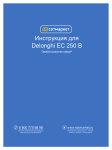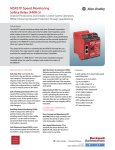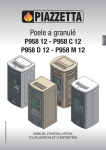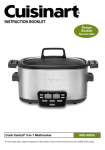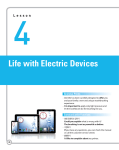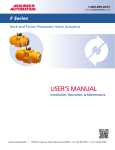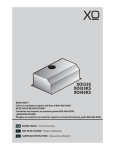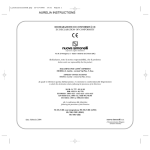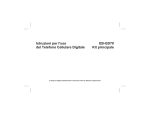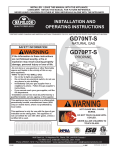Download De'Longhi Coffeemaker EC250 User's Manual
Transcript
De’Longhi Appliances via Seitz, 47 31100 Treviso Italia 5713216671/06.11 EC250 Instructions for use COFFEE MAKER Electrical connection (uk only) Before using this appliance ensure that the voltage indicated on the product corresponds with the main voltage in your home, if you are in any doubt about your supply contact your local electricity company. The flexible mains lead is supplied connected to a B.S. 1363 fused plug having a fuse of 13 amp capacity. Should this plug not fit the socket outlets in your home, it should be cut off and replaced with a suitable plug, following the procedure outlined below. Note: Such a plug cannot be used for any other appliance and should therefore be properly disposed of and not left where children might find it and plug it into a supply socket - with the obvious consequent danger. Please note: We recommend the use of good quality plugs and wall sockets that can be switched off when the machine is not in use. IMPORTANT: The wires in the mains lead fitted to this appliance are coloured in accordance with the following code: Green and Yellow to Earth GREEN AND YELLOW BLUE BROWN 13 amp Fuse EARTH NEUTRAL LIVE Blue to neutral Brown to live Cord Clamp As the colours of the wires in the mains lead of this appliance may not correspond with the coloured markings identifying the terminals in your plug, proceed as follows: - The wire which is coloured green and yellow must be connected to the terminal in the plug which is marked with the letter E or by the earth symbol or coloured green or green and yellow. - The wire which is coloured blue must be connected to the terminal which is marked with the letter N or coloured black. - The wire which is coloured brown must be connected to the terminal which is marked with the letter L or coloured red. When wiring the plug, ensure that all strands of wire are securely retained in each terminal. Do not forget to tighten the mains lead clamp on the plug. If your electricity supply point has only two pin socket outlets, or if you are in doubt, consult a qualified electrician. Should the mains lead ever require replacement, it is essential that this operation be carried out by a qualified electrician and should only be replaced with a flexible cord of the same size. After replacement of a fuse in the plug, the fuse cover must be refitted. If the fuse cover is lost, the plug must not be used until a replacement cover is obtained. The colour of the correct replacement fuse cover is that of the coloured insert in the base of the fuse recess or elsewhere on the plug. Always state this colour when ordering a replacement fuse cover. Only 13amp replacement fuses which are asta approved to B.S. 1362 should be fitted. This appliance conforms to the Norms EN 55014 regarding the suppression of radio interference. Warning - this appliance must be earthed 2 Description ! , % '* , + &, #"#"!- !- ( $"!- ) 3 First use Open the lid and remove the water tank Fill the tank (do not pass the MAX level) 3 4 MAX 1 Plug the appliance in 2 Switch the appliance on 5 Attach the filter holder Reposition the tank Insert the empty filter 6 Place 2 empty containers 7 Wait until light comes on OK! 8 Push the button 9 Turn the switch 10 STOP Once emptied the water tank... 11 12 4 13 Empty the containers OF Repeat Steps 1 to 4 and Steps 9 to 14 14 Y! READ 15 Pre-heating the coffee machine and cup Carry out steps (1-8) Place a cup Fill the cup with hot water Stop flow 16 17 Empty the cup Place the required filter in the filter holder, then proceed with making an espresso (page 6) 5 18 Espresso If you want filter to use coffee quantity 1 Espresso 1-cup/ 1-pod coffee filter 2Espresso s x2 2-cups coffee filter 19 Press the coffee powder according to taste light al norm g stron OK! STOP FLOW EspressoReady! 6 Cappuccino Push the button and wait for the light to come on M a serpnak o ON! It is recommended to use semi-skimmed milk at refrigerator temperature. 5°C OK! (page6) max 1/3 20 21 Position the container under the cappuccino nozzle Open the steam switch Use about 100 grams of milk for every cappuccino to be prepared. When choosing the container bear in mind that the volume of the milk will increase by 2 or 3 times. 60s Max. 23 22 Pour the frothed milk into the cups containing the previously prepared espresso coffee. STOP To obtain a creamier froth, dip the cappuccino nozzle into the milk and turn the container with slow movements from the bottom upwards. When the volume of the milk has doubled, dip the cappuccino nozzle deep down and continue to heat the milk. 24 Cappuccino Ready! For hygiene purposes always clean the cappuccino nozzle after each use 7 Cleaning (page 8) Cleaning after making a Cappuccino 5s Discharge a small amount of steam Use one hand to hold the cappuccino tube and the other to release the cappuccino maker STOP 1 25 Remove the cappuccino nozzle 26 Wash and clean using a pin 28 2 27 Re-mount the cappuccino maker 29 30 Hot Water Wait until light comes on Push the button and turn the steam dial at the same time OK! 31 60s Max. 32 STOP Ready! 35 34 8 33 Cleaning During cleaning, never immerse the machine in water: it is an electrical appliance. Before performing any cleaning operations to the external parts of the appliance, switch the machine off, remove the plug from the socket and let the machine cool down. Emptying the drip tray The drip tray is fitted with a level indicator showing the level of water it contains. Before the indicator protrudes from the cup tray, the drip tray must be emptied and cleaned. Cleaning filters and boiler outlet Clean the filter-holder, ground coffee filter and boiler outlet about every 300 coffees or if the coffee drips through the filter-holder and does not flow unrestricted. OF x300 C2 C3 9 Descaling and Rinse Read the safety warnings of the descaler x200 Prepare the descaling solution following the instructions given on the pack (fig. 1-2) Place 2 empty containers + IRRITANTE - IRRITANT REIZEND - IRRITEREND i i (fig. 4) (fig. 6) Descaling 1. Push the button Repeat MA X 2 3 4 x3 Repeat this sequence 3 times, until the tank is completely empty 2. Turn the steam switch for 5 seconds 5 min 5s 3. Close the steam switch and allow about 1/4 of the solution contained in the tank flow out. Empty the containers 1 2 3 4 5. Leave the solution to act for about 5 minutes 4. Push the button to interrupt STOP Fill the tank and proceed rinsing Rinse the water tank (fig. 1-4) Rinse 10 Descaling and Rinse Rinse Y! 1. Push the button Repeat 2. Turn the steam switch for 5 seconds READ (fig. 1-4) 6. Fill the tank and repeat rinse once 5. Empty the containers and put them back in place 5s 3. Close the steam switch and allow all the water in the tank to flow out. STOP 4. Push the button to interrupt Technical data - Disposal Disposal Technical data Mains voltage: Absorbed power: Sizes LxHxD: Pressure: Water tank capacity: Power supply cable length: Weight: 220-240V˜50/60Hz 1100W 208x325x305 (380) mm 15 bar 1L 1.2 m 3.8 kg The appliance is in compliance with the following CE Directives: t 4UBOECZ%JSFDUJWF t -PX WPMUBHF %JSFDUJWF $& BOE TVDDFTTJWF amendments; t &.$%JSFDUJWF$&BOETVDDFTTJWFBNFOENFOUT t 5IF NBUFSJBMT BOE JUFNT JOUFOEFE GPS DPOUBDU XJUI GPPE comply with the requirements of European Regulation 1935/2004. 11 Recommendations for the correct disposal of the product in compliance with the 2002/96/EC European Directive and Legislative Decree n. 151 dated 25 July 2005. The product must not be disposed of as urban waste at the end of its working life. It must be taken to appropriate local authority separate waste collection centres or to dealers providing this service. Disposing of a household appliance separately avoids possible negative consequences for the environment and health deriving from unsuitable disposal and allows to recover the materials of which it is made in order to make significant savings of energy and resources. The product has the crossed-out wheeled bin mark as a reminder of the obligation to dispose of household appliances separately. The illegal disposal of the product by the user entails the application of administrative sanctions envisioned by the Standard in force. Troubleshooting Problem Possible causes Solution Espresso coffee does not flow out There is no water in the tank Fill the water tank The holes in the filter-holder are blocked Clean the holes in the filter-holder spouts The espresso boiler outlet is blocked Clean as indicated in the “Cleaning” paragraph The filter-holder is not correctly inserted or is dirty Attach the filter-holder correctly and turn it fully until it is firmly engaged The espresso boiler gasket has lost elasticity or it is dirty Contact De’Longhi Customer Experience in order to replace the espresso boiler gasket The holes in the filter-holder spout are blocked Clean the holes in the filter-holder spouts At first use there is air in the system Carry out the “first use” cycle (see page 4) The water tank is empty Fill the tank The tank is inserted incorrectly and the valve on the bottom is not open Press the tank lightly to open the valve on the bottom The ground coffee is pressed too tightly Tamper the coffee less There is too much ground coffee Reduce the amount of ground coffee The espresso boiler outlet is blocked Clean as indicated in the “Cleaning” paragraph The filter is blocked Clean as indicated in the “Cleaning” paragraph The coffee is ground too finely Only use coffee specifically ground for espresso coffee machines The ground coffee is too fine or is moist Only use coffee specifically ground for espresso coffee machines. The coffee should not be moist Incorrect type of ground coffee Change the quality of the ground coffee powder Coffee is too strong See notes above Rinsing after descaling was not sufficient Repeat rinsing (see page 11) light is not on when the button The is pressed Wait for the light to switch on Pre-heating has not been carried out See page 5. The milk is not cold enough Always use milk at fridge temperature The cappuccino maker is dirty Thoroughly clean the holes of the cappuccino maker Espresso coffee drips from the edges of the filter-holder instead of through the holes Loud pump noise The coffee crema is dark (coffee flows slowly from the spout) The coffee has an acidic flavour The espresso coffee is cold The milk does not froth when making a cappuccino 12 Safety warnings Symbols used in these instructions The important recommendations have these symbols. These recommendations must be followed. Important: Do not allow the appliance to be used by persons (also children) with reduced psycho-physical-sensorial capacities or that have insufficient experience and knowledge, unless they are carefully monitored and trained by a person responsible for their safety. Watch children, do not let them play with the appliance. Danger! Failure to comply can be or is the cause of injury due to lifethreatening electric shocks. Important! Failure to comply can be or is cause of injury or damage to the appliance. Scalding hazard! This appliance produces hot water and steam may form when it is operating. Pay attention not to come into contact with hot water sprays or steam. Do not touch the cup holder, the frothing tube, or the boiler outlet when the appliance is on because it is hot. Scalding hazard! Failure to comply can be or is the cause of scalding or burns. Please note: This symbol highlights recommendations and important information for the user. Use in compliance with intended use This appliance is designed and made to prepare coffee and heat drinks. All other use is considered improper. This appliance is not suitable for commercial use. The manufacturer is not liable for damage deriving from improper use of the appliance. This is an household appliance only. It is not intended to be used in: t TUBò LJUDIFO BSFBT JO TIPQT PóDFT BOE PUIFS XPSLJOH environments; t GBSNIPVTFT t CZ DMJFOUT JO IPUFMT NPUFMT BOE PUIFS SFTJEFOUJBM UZQF environments; t CFEBOECSFBLGBTUUZQFFOWJSPONFOUT Use in this manner will invalidate the manufacturers warranty. Fundamental recommendations regarding safety Danger! As the appliance operates using electricity, electric shocks can not be excluded. Therefore, follow the safety recommendations given: t %POPUUPVDIUIFBQQMJBODFXIFOZPVIBWFXFUIBOETPS feet. t %POPUUPVDIUIFQMVHXJUIXFUIBOET t .BLF TVSF UIBU UIF TPDLFU VTFE DBO BMXBZT CF FBTJMZ reached, so that the plug can be removed when required. t 3FNPWF UIF QMVH GSPN UIF TPDLFU CZ BDUJOH EJSFDUMZ PO the plug itself. Do not pull the cable as damage could be caused. t 3FNPWF UIF QMVH GSPN UIF TPDLFU UP EJTDPOOFDU UIF appliance completely. t %P OPU BUUFNQU UP SFQBJS UIF BQQMJBODF JG JU TIPVME breakdown. Turn it off, unplug from the mains socket and contact the Technical Assistance service. t *GUIFQMVHPSQPXFSTVQQMZDBCMFBSFEBNBHFEIBWFUIFN replaced exclusively by the De’Longhi After-Sales Service, in order to prevent risks t %VSJOHDMFBOJOHOFWFSJNNFSTFUIFNBDIJOFJOXBUFSJU is an electrical appliance. t #FGPSFQFSGPSNJOHBOZDMFBOJOHPQFSBUJPOTPGUIFFYUFSOBM parts of the appliance, switch the machine off, remove the plug from the socket and let the machine cool down. Instructions for use Read these instructions carefully before using the appliances. Failure to comply with these instructions can lead to injury to persons and damage to the machine. The manufacturer is not liable for damage deriving from the failure to comply with the user instructions. Please note: Keep these instructions carefully. If the appliance should be transferred to other persons, these instructions must accompany it. Please note: first use Upon first use, rinse the internal ducts of the device, and operate the device like one would to make coffee until at least one water tank has been emptied; then proceed with making coffee. Important: Keep the packaging material (plastic bags, expanded polystyrene) out of the reach of children. 13














